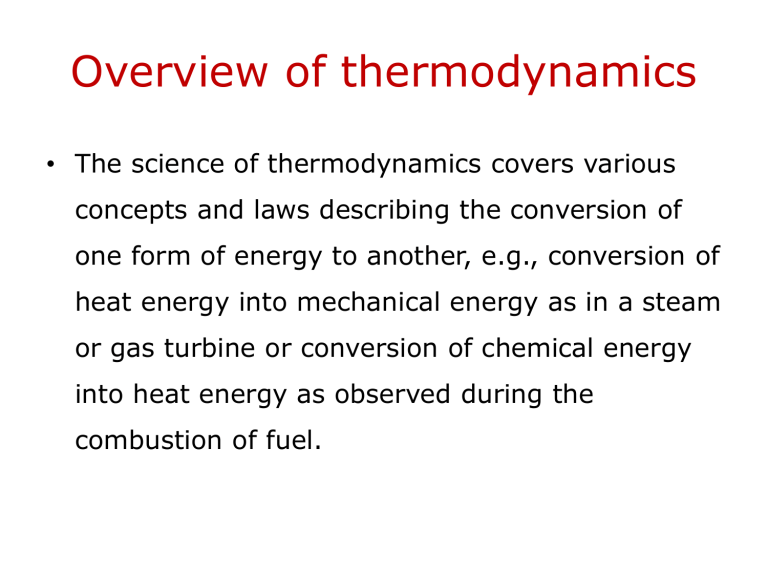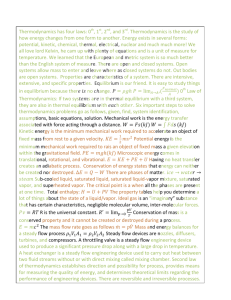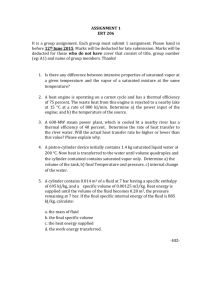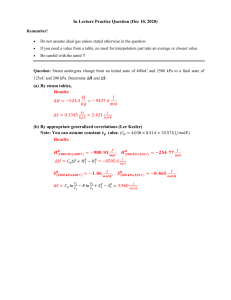
Overview of thermodynamics • The science of thermodynamics covers various concepts and laws describing the conversion of one form of energy to another, e.g., conversion of heat energy into mechanical energy as in a steam or gas turbine or conversion of chemical energy into heat energy as observed during the combustion of fuel. Laws of thermodynamics 1. First law of thermodynamics In a cyclic process, since the initial and final states are identical, the net quantity of heat delivered to the system is proportional to the net quantity of work done by the system. When heat and work are mutually convertible, we have the first law of thermodynamics. Mathematically speaking, where Q = Heat supplied to the system, W =Work done by the system. The steady-state equation Where C is velocity of the mass at inlet or exit Z is elevation at inlet or exit g is acceleration due to gravity Neglecting the effects of kinetic and potential energies Eq. 1.2 reduces to when a system passes through a cyclic process U2 = U1 and Q = W ….(1.3) The change in the internal energy of the system may be expressed as dU, the change in heat flow as dQ, and the change in net work done as dW. Accordingly Eq. 1.3 changes to: dU = dQ - dW ……(1.4) In a constant pressure process, dW = pdV where p is pressure and dV represents the change in volume of the system on completion of the process, Eq. 1.4 changes to: dU = dQ - pdV or, dQ =dU + pdV (1.5) Since p is constant, pdV = d(pV), therefore, Eq. 1.5 may be written as dQ = dU + d(pV) or, dQ = d(U + pV) (1.5) In thermodynamics the quantity (U + pV) occurs frequently, and is identified with a special property called enthalpy H. Therefore, dQ =dH (1.7) Following the above expression of enthalpy, the specific enthalpy (enthalpy per unit mass), represented by h in thermodynamics, is expressed in a state of equilibrium as h = u + pv (1.8) for an isentropic process changes to dh = vdp (1.9) Integrating Eq. 1.9 between state 2 and state 1 it is found that h2 - h1 ≈ v(p2 - p1) (1.10) Second law of thermodynamics Concept of entropy: Mathematically expressed as: dS = dQ/T Integrating Eq. 1.14 ∫dQ/T = (S2 - S1) where S = Entropy of the system Q= Heat supplied to the system T = Temperature of the system (1.14) (1.15) From Eqs. 1.14 and 1.15 we may note that for a adiabatic process dQ = 0, dS = 0 and for an isothermal process T = T2 =T1 and Q = T (S2 - S1). Combining Eq. 1.7 and Eq. 1.14, dS = dH/T or, dH = TdS (1.16) or, per unit mass dh + Tds (1.17) Classification Of Power Plant Cycle • Power plants cycle generally divided in to the following groups: (1) Vapour Power Cycle (Carnot cycle, Rankine cycle, Regenerative cycle, Reheat cycle, Binary vapour cycle) (2) Gas Power Cycles (Otto cycle, Diesel cycle, Dual combustion cycle, Gas turbine cycle.) Steam Power Plant Important definitions: Saturation temperature: is the temperature a pure substance start boiling at certain pressure, this pressure is called saturation pressure. Saturated liquid: if a pure substance exists as liquid at saturation temperature and pressure, it is called saturated liquid. Wet mixture: is the mixture of liquid and its vapor. • Saturated vapor: if a pure substance exists as vapor at saturated temperature and pressure, it is called saturated vapor. • Moisture content: is the ratio of liquid mass to the total mass (mass of liquid and mass of vapor). • Dryness fracture (x): is a ratio of vapor mass to the total mass. vf : specific volume of saturated liquid. vg : specific volume of saturated vapor. vfg : difference between vg and vf (that is , vfg= vg- vf • Enthalpy of vaporization (hfg): or latent heat of vaporization, It represent the amount of energy needed to vaporize a unit mass of saturated liquid at a given temperature or pressure. • Super heated vapor: When the temperature of the vapor is higher than the saturated temperature of this vapor is called super heated vapor. • Enthalpy of water (hf): is the enthalpy of heat absorbed by unit mass of water at constant pressure until it reaches to the temperature of vapor forming from (0 °C). • Enthalpy of dry steam (hg): is the quantity of heat which needed to change unit mass of water at (0ºC) to dry steam. • Specific volume of wet steam: v = vf + x vfg 1. CARNOT CYCLE This cycle is of great value to heat power theory although it has not been possible to construct a practical plant on this cycle. It has high thermodynamics efficiency. It is a standard of comparison for all other cycles. The thermal efficiency (η) of Carnot cycle is as follows: • In P-V (Pressure-Volume) and T-S (TemperatureEntropy) diagrams (Figure 1.5) the cycle is represented by an area bounded by the following two isothermals and two adiabatic processes: i. 1-2: Reversible adiabatic expansion ii. 2-3: Reversible isothermal heat rejection iii. 3-4: Reversible adiabatic compression iv. 4-1: Reversible isothermal heat addition. State 4 in Figure 1.5 refers to saturated liquid and state 1 refers to saturated vapor. Example 1.1 Using Figure 1.5, calculate the efficiency and exhaust steam quality of a steam cycle operating between 4 MPa and 10.13 kPa. Solution: From the steam table the following values have been found corresponding to steam pressures 4 MPa and 10.13 kPa: Example 1.2 Consider the Carnot cycle of Figure 1.5 and calculate the heat transfers, net work output, cycle efficiency, and specific steam consumption (s.s.c), using steam operating between pressures 8 MPa and 9.6 kPa. Solution: From the steam table the following values have been found corresponding to steam pressures 8 MPa and 9.6 kPa:





